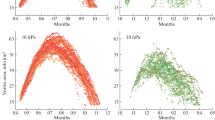Abstract
Using numerical simulation, a mechanism of formation of polar cyclones in the region of location of the arctic front in the winter troposphere of the Northern Hemisphere is studied. The simulation was performed with the help of the complete system of gas dynamics equations taking into account the transport of infrared radiation, phase transitions of water vapor into micro-drops of water and ice particles, and with allowance made for sedimentation of these drops and ice particles in the gravity field. In the initial and boundary conditions of the model, observational data on the structure of dominating air flows in the region of the arctic front over Norwegian Sea in January are used. Formation of large-scale cyclonic vortex flows in 15–20 hours at the presence of a bend of the central line of the shear flow in the arctic front 500–600 km long with northward or southward deviations by 100 km and more is obtained numerically. On the basis of the simulation results, a method of short-term forecast of formation and motion of polar cyclones is suggested.
Similar content being viewed by others
References
Zabolotskikh, E.V., Myatlik, L.M., and Bobylev, L.P., Polar Cyclone in Norwegian See on January, 30–31, 2008: Analysis of Data of Multi-Sensor Satellite Sounding, in Shestaya vserossiiskaya otkrytaya ezhegodnaya konferentsiya “Sovremennye problemy distantsionnogo zondirovaniya Zemli iz kosmosa” Sb. tezisov (Sixth All-Russia Open Annual Conference “Modern Problems of Remote Sounding of the Earth from Space,” November 10–14, 2008: Book of Abstracts), Moscow: IKI RAN, 2008.
Belotserkovskii, O.M., Mingalev, I.V., Mingalev, V.S., et al., Mechanism of Origination of a Large-Scale Vortex in the Troposphere over Non-Uniformly Heated Surface, Dokl. Akad. Nauk, 2006, vol. 410, no. 6, pp. 816–820.
Belotserkovskii, O.M., Mingalev, I.V., Mingalev, V.S., et al., Formation of Large-Scale Vortices in Shear Flows of the Lower Atmosphere in the region of Tropical Latitudes, Kosm. Issled., 2009, vol. 47, no. 6, pp. 501–514. [Cosmic Research, pp. 466–479.]
Obukhov, A.M., Turbulentnost’ i dinamika atmosfery (Turbulence and Dynamics of the Atmosphere), Leningrad: Gidrometeoizdat, 1988.
Mingalev, I.V. and Mingalev, V.S., A Model of Common Circulation of the Lower and Middle Atmosphere of the Earth at a Preset Temperature Distribution, Mat. Model., 2005, vol. 17, no. 5, pp. 24–40.
Trotsenko, A.N. and Fomin, V.A., Calculating Characteristics of Heat Radiation Transfer in the Atmosphere Based on the Direct Integration Method, Izv. Akad. Nauk SSSR, Fiz. Atmos. Okeana, 1989, vol. 25, no. 1, pp. 106–109.
Mingalev, V.S., Mingalev, I.V., Mingalev, O.V., et al., Generalization of Monotonic Second Order Hybrid Scheme for Gas Dynamics Equations to the Case of Irregular Spatial Grid, Zh. Vychislit. Mat. i Mat. Fiziki, 2010, vol. 50, no. 5, pp. 923–936.
Oparin, A.M., Numerical Simulation of Problems Related to Intense Development of Hydrodynamic Instabilities, in Novoe v chislennom modelirovanii: algoritmy, vychislitel’nyi eksperiment, rezul’taty (New Issues in Numerical Modeling: Algorithms, Computational Experiments, and Results), Moscow: Nauka, 2000.
Belotserkovskii, O.M., Kraginskii, L.M., and Oparin, A.M., Numerical Modeling of the Three-Dimensional Flows in a Stratified Atmosphere, Caused by Strong Large-Scale Disturbances, Zh. Vychislit. Mat. i Mat. Fiziki, 2003, vol. 43, no. 11, pp. 1744–1758.
Picone, J.M., Hedin, A.E., Drob, D.P., and Alkin, A., NRLMSISE-00 Empirical Model of the Atmosphere: Statistical Comparisons and Scientific Issues, J. Geophys. Res., 2002, vol. 107, no. A12, pp. 1468–1483.
Author information
Authors and Affiliations
Corresponding author
Additional information
Original Russian Text © I.V. Mingalev, K.G. Orlov, V.S. Mingalev, 2012, published in Kosmicheskie Issledovaniya, 2012, Vol. 50, No. 2, pp. 166–175.
Rights and permissions
About this article
Cite this article
Mingalev, I.V., Orlov, K.G. & Mingalev, V.S. A mechanism of formation of polar cyclones and possibility of their prediction using satellite observations. Cosmic Res 50, 160–169 (2012). https://doi.org/10.1134/S0010952512010066
Received:
Published:
Issue Date:
DOI: https://doi.org/10.1134/S0010952512010066




